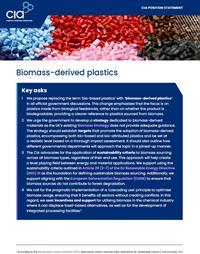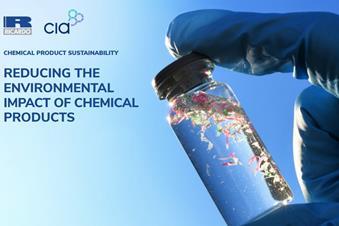Explore this page: Key asks | Barriers and enablers to adoption | Benefits of Biomass-derived plastics | Definition | Targets | Sustainability criteria | Cascading principle
This position paper explores the urgent need for the UK to enable a shift towards competitive and sustainable feedstocks, including biomass-derived plastics and outlines the support the chemical industry needs from government to enable this transition.
Download full document
Plastic has become an indispensable material in modern life, with applications spanning every sector, from packaging and construction to electronics and healthcare. However, traditional plastic production relies on fossil-based feedstocks, primarily oil and natural gas. This, in addition to the inadequate handling of plastic waste is contributing to the depletion of finite resources; the generation of greenhouse gases (GHGs); and destruction of the environment driving climate change. However, there is an increasing opportunity for alternative, sustainable materials that can offer reduced environmental impact, particularly in terms of carbon emissions.
Biomass-derived plastics, produced from renewable feedstocks such as plant-based materials, present a promising solution to address these concerns. By adopting biomass-based feedstocks, the chemical industry can reduce its reliance on fossil fuels, decrease carbon emissions, and contribute to a more sustainable and circular economy.
Key asks
- We propose replacing the term ‘bio-based plastics’ with ‘biomass-derived plastics’ in all official government discussions. This change emphasises that the focus is on plastics made from biological feedstocks, rather than on whether the product is biodegradable, providing a clearer reference to plastics sourced from biomass.
- We urge the government to develop a strategy dedicated to biomass-derive materials as the UK’s existing Biomass Strategy does not provide adequate guidance. The strategy should establish targets that promote the adoption of biomass-derived plastics, encompassing both bio-based and bio-attributed plastics and be set at a realistic level based on a thorough impact assessment. It should also outline how different governmental departments will approach the topic in a joined-up manner.
- The CIA advocates for the application of sustainability criteria to biomass sourcing across all biomass types, regardless of their end use. This approach will help create a level playing field between energy and material applications. We support using the sustainability criteria outlined in Article 29 (2-7) of the EU Renewable Energy Directive (RED) III as the foundation for defining sustainable biomass sourcing. Additionally, we support aligning with the European Deforestation Regulation (EUDR) to ensure that biomass sources do not contribute to forest degradation.
- We call for the pragmatic implementation of a ‘cascading use’ principle to optimise biomass usage, ensuring that it benefits all sectors without creating conflicts. In this regard, we seek incentives and support for utilising biomass in the chemical industry where it can displace fossil-based alternatives, as well as for the development of integrated processing facilities.
Barriers and enablers to adoption
| | Barriers | Enablers |
|---|
|
Cost
|
Higher feedstock costs, limited economies of scale, and new technology requirements. Oil and gas subsidies put bio-based chemicals on an unlevel playing field.
|
Government incentives and supports (e.g. subsidies) linked to a carbon tax calculated on a cradle-to-grave basis. This would ensure biomass is directed toward the most impactful uses, particularly in the chemicals industry, where it can deliver environmental and economic benefits.
|
|
Performance issues
|
Inconsistent or inferior performance compared to traditional materials in some applications, limited durability or shelf life for certain products, and challenges in maintaining product quality across various environmental conditions.
|
Government investment in research and development programmes through UKRI.
|
|
Technical issues
|
Difficulty in achieving specific material properties, e.g., barrier properties, heat resistance.
|
Government investment in research and development programmes through UKRI.
|
|
Technological gaps
|
Limitations in processing capabilities using existing equipment and challenges in scaling up production processes.
|
Government support to derisk investments to scale up production.
|
|
Regulatory issues
|
Misapplication of the Waste Hierarchy, lack of standardised certification and labelling systems, and complex approval processes for new materials, especially in sensitive applications like food packaging.
|
A dedicated strategy for biomass-derived materials, promoting standardised terminology.
|
|
Supply chain interrogation
|
Interrogation can be difficult for new materials and requires collaboration across different sectors (agriculture, chemicals, waste management).
|
The strategy should outline a joined-up approach across governmental departments to promote harmony across sectors.
|
|
Feedstock availability and sustainability
|
Regional and seasonal variation can make for a volatile market.
|
Research and guidelines are needed to address concerns about perceived competition with food production and sustainability of certain feedstock sources. This should include guidance on the best available use of biomass, e.g. Green Rose Chemistry’s proposed ‘biomass hierarchy’ (see Figure 1).
|
|
Market acceptance and consumer awareness
|
Understanding of bio-based, biodegradable, and compostable materials is lacking, leading to misconceptions about performance and environmental benefits of these materials.
|
Improve awareness of biomass-derived materials and their properties, both at the public and policy-maker level.
|
|
Environmental impact uncertainties
|
Concerns about unintended consequences of some materials (e.g. microplastic formation and littering), and debate over the true environmental benefits in different scenarios.
|
Standard methodological guidelines for environmental impact assessment and/or lifecycle assessments are needed. E.g. BB-REG-NET, the UK’s first regulatory science network for bio-based and bio-degradable materials.
|
|
Infrastructure and end-of-life management
|
Inadequate recycling guidelines, composting infrastructure, and sorting systems for different types of bio-based and compostable materials. Perceived risk of contamination in recycling streams if not properly sorted.
|
Implementation of a waste strategy with a uniform approach to collection, including waste biomass.
|
Please download full document to view graphics ^
Benefits of biomass-derived plastics
Sustainability: biomass-derived plastics are made from naturally occurring polymers. As long as the resources are sustainably grown and processed, these plastics contribute to a circular economy.
Cleaner production: the production of biomassderived plastics requires less energy and results in lower GHG emissions compared to traditional fossil-based plastics.
Biodegradability: bioplastics, like PLA (polylactic acid) and PHA (polyhydroxyalkanoates), are biodegradable and compostable. However, they require high and constant temperatures to break down, limiting their use to industrial composting facilities. Since the UK currently lacks industrial composting infrastructure, it is essential to invest in such facilities and implement clear, consistent standards and labelling to minimise the long-term environmental impact of plastic waste.
Job creation and rural development: bioplastics production stimulates rural economies, creating jobs in farming, processing, and plastics manufacturing.
Market growth and innovation: the bioplastics sector is growing rapidly, driving new business opportunities and global competitiveness.
Material innovation: bioplastics development is improving the properties of bioplastics (e.g., strength, flexibility, and heat resistance), opening new applications.
Manufacturing efficiency: advanced processes, such as fermentation and enzymatic processes, could make the manufacturing process more energy-efficient and environmentally friendly.
Definition
In alignment with the European chemicals federation, Cefic and the European Chemical Council, CIA recommends shifting the focus of the conversation from bio-based plastics to biomass-derived plastics.
Biomass-derived plastics encompass:
- Bio-based plastics, which are those where the share of bio-based content can be measured using established radiocarbon methods. These can be fully or partially bio-based.
- Bio-attributed plastics, which are those where the use of bio-based feedstocks, substituting part of the raw material in the manufacturing process, has been attributed to the product via the mass balance accounting method. The mass balance approach is a chain-of-custody system ensuring that the biobased feedstock is accurately accounted for, even if the final product results from a blend of feedstocks from different origins. Mass balance has been accepted for the purpose of calculating recycled content in plastic packaging for the purpose of the Plastic Packaging Tax and CIA are part of HMRC’s technical working group to assist implementation.
Thus, biomass-derived plastics refer to plastics wholly or partly derived from biomass, encompassing both bio- based and bio-attributed plastics.
It is essential to ensure that claims regarding biomass- derived plastics are transparent about the type of plastic they refer to, as well as the amount of bio-based feedstock used in the product or its content.
Further definitions related to end-of-life characteristics of plastics (e.g. compostability, recyclability) should not be included in the definition to prevent confusion between the product definition and its end-of-life attributes.
Targets
In the EU, the Commission is assessing the progress of technological advancements and environmental performance in bio-based plastic packaging, as well
as considering the introduction of targets to encourage the use of biomass-derived plastics. The CIA suggests that the UK carry out a similar evaluation to promote the circulation of sustainable feedstocks within the domestic economy, supporting the achievement of environmental objectives.
When setting targets for increasing the use of biomass in plastic packaging, it is important to include both bio- based and bio-attributed plastics, allowing all relevant
technologies to contribute to the shift toward sustainable carbon sources. These targets should be based on a thorough impact assessment that takes into account factors like the availability of sustainable biomass,
the technical and economic viability of converting biomass into plastics, market trends, and broader socio- economic considerations.
Sustainability criteria
Establishing a clear set of sustainability criteria for biomass sourcing that apply to all biomass regardless of its final use is essential. It is the first step to reach a level playing field for all sectors using biomass whether for energy or material uses. CIA support using the sustainability criteria set out in Article 29 (2-7) RED III, which would keep us in line with proposals being explored in the EU, to define the boundaries for sustainable biomass sourcing.
Cascading principle
The principle of ‘cascading use’ should not be seen as a rigid tool prescribing specific priority uses for biomass or creating complex socioeconomic hierarchies. Instead, its goal should be to optimise the efficiency of biomass use while minimising environmental impact through well- designed incentives.
The EU Directive EU/2023/2413 (RED III) already outlines the cascading use of woody biomass. The focus is
on supporting schemes that prevent incentivising unsustainable practices and avoid market distortions between biomass and materials sectors, ensuring that biomass is utilised in ways that offer the greatest economic and environmental benefits.
The initial policy step should be to promote the material uses of biomass in industries like chemicals, for example by introducing policies that encourage biomass-derived products. This is vital because the primary barrier to using bio-based feedstocks is their lack of price competitiveness compared to fossil fuels.
It is important to recognise the potential for synergies between different biomass applications across sectors. The development of integrated processing facilities will be crucial for bio-based feedstocks, as they can co-produce a range of products (chemicals, plastics, and fuels), leading to more sustainable, interconnected processes. Therefore, incentives should focus on fostering integrated value chains, creating complementary, rather than competing, demands across sectors.

CIA Biomass derived plastics: Policy Paper 2025
Download to read full document on the urgent need for the UK to enable a shift towards competitive and sustainable feedstocks, including biomass-derived plastics.
DOWNLOADPDF | 759 Kb





















